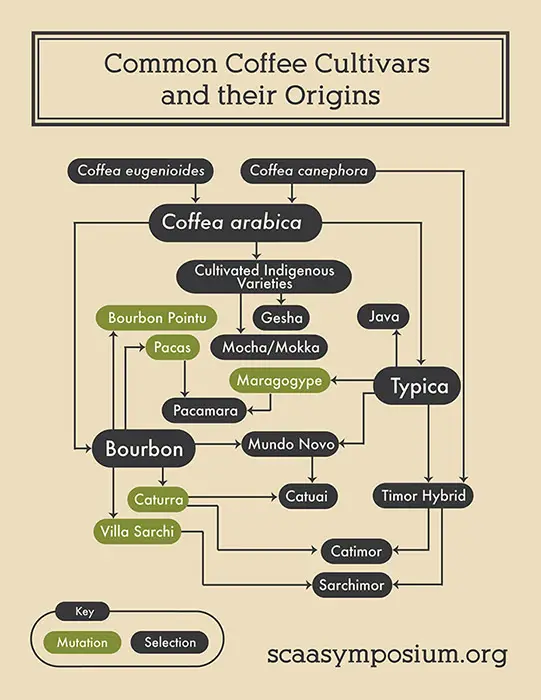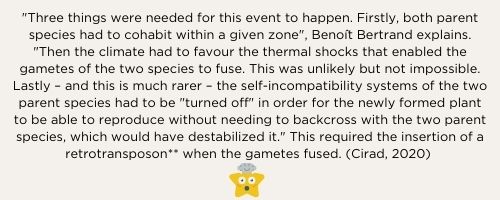Imagine going to a party, it is the first party in quite some time, you are excited to catch up with friends, but then your Mum arrives and steals the show. Well, that just happened at the WCE series of competitions in Milan.

Coffea eugenioides, the ‘mother’ progenitor of Coffea arabica, has traditionally been a loner species, doing its own thing while arabica got all the glory with its exotic varieties, and higher yields. This has now changed, from uncool parent, eugenioides has had a makeover, landing places 1,2 and 3 World Barista Championship and winning the World Brewers Cup. Eugenioides, the OG is back on the world stage.
Marked by great sweetness, famous for its strange and exotic flavours such as cereal, basil, musk, tropical fruits, lemon verbena, peach, maple syrup and other complex aroma and flavours all in one cup. It is balanced with high sweetness low acidity and bitterness; smooth and silky in mouthfeel. Rich, round, lingering and layered in the finish, it is a competitor’s coffee dream. It sounds incredible, and it is. It has attracted baristas and roasters with demand far outstripping supply. Where has this coffee come from and what does the future hold?
The first use of eugenioides on the world stage was the Brewer’s cup in Gothenberg, 2015, by Sarah Anderson (USA). The coffee was produced on Finca Inmaculada, Cauca, Colombia and credited to Camilo Merizalde. The coffee and of course brewing expertise, earned a second place that year. Watching the performance, there is little focus on processing, it is all about the species and flavour notes. This reflects both how the competition has developed but also the novelty of the coffee.
The 2021 world championships in Milan saw eugenioides feature in the top 3 of the Barista championships and gain the top place for the Brewers Cup. We haven’t seen this kind of dominance since the storied early days of geisha on the competition circuit.
The new World Barista Champion, Diego Campos of Colombia, sourced his coffee from Finca Las Nubes, produced by Julian Holguin. Both Andrea Allen (2nd, USA) and Hugh Kelly (3rd, Australia) sourced their eugenioides from Finca Inmaculada and also credited Julian Holguin. While Matt Winton (Switzerland) the new World Brewer’s cup champion also sourced his eugenioides coffee from Finca Inmaculada. In retrospect it seems like this coffee was a sure win, but in reality it was a highly risky gamble that paid off for these champions. It took a lot of courage to choose such an experimental coffee for the world championship competitions, and true expertise to succeed with it in their respective, unique routines.
A few lucky roasters have been able to get their hands on the harvests of some farms such as Finca Inmaculada’s like Onyx Coffee Lab USA, Gardelli Coffee, Italy and Amor Perfetto, Colombia. Unsurprisingly, they have all sold out of the coffees, though you can buy coffee grown by the WBC Champion. All 3 roasters took a risk in buying such an expensive coffee. Luckily it has paid off and will help secure a market for the crops in the years to come.
Growing coffees that producers are already familiar with, is challenging enough especially with the increasingly harsh conditions brought about by climate change and associated issues like pests and coffee leaf rust. Taking on a new species is now even more risky. The plants, growing on Finca Inmaculada were originally in large poly tunnel structured ‘green houses’ where 5000 plants were carefully grown. However, this proved to be counter productive, so it was removed (Holguin, Coffee Man podcast). The yield from each plant is said to be as low as 150g, roughly 128g of roasted coffee (Sestic, Coffee man podcast). For context, this is less than half of what an Arabica species could produce. So, it is easy to see why producers have not rushed to grow this coffee varietal.
After starting to cultivate the varietal, the first harvest with eugenioides is after 3 years, but higher yields take at least 5 years (Charrier, 2020). The yield means 5000 trees could theoretically produce 637kg of coffee, but a smaller percentage of that overall crop is going to be specialty, and an even smaller one competition grade. On the basis that the highest risk, should command the highest return, the producers on Fincas Las Nubes and Inmaculada are visionaries who deserve the highest returns. Growing coffee is a long term gamble with inbalances in price risk, market and environmental volatility.
Eugenioides is a rare and experimental coffee to grow outside of its native habitat. In fact, it has not been considered commercially viable even in its home regions where the offspring of vibrant higher yielding wild plants become low yielding and less healthy when commercial cultivation was attempted (Charrier, 2020) (Figure 1. Native growing regions). Producers in its native habitats have consistently favoured arabica and C. canephora (robusta) as the most viable commercial coffee crops (Charrier, 2020).

Figure 1: Native growing regions – Burundi, Kenya, Rwanda, Sudan, Tanzania, Uganda, DRC
A 2020 study from Scaladin et al. found some remarkable things. Firstly an extremely rare event- 2 species canephora, the father, and eugenioides, the mother, cross bred and produced arabica (Cirad.fr, 2020)(see figure 2). Geneticists refer to this as polyploidization (Figure 2). Secondly, as a result of this cross breeding and its relative recency within the last 20,000 years, the genetic diversity of arabica is very low. Furthermore, as a result of the genetic heritage of arabica, it is unlikely that there is much genetic diversity within the arabica species, even if we do exploit the more diverse and unknown Ethiopian strains, or germplasm.

Figure 2. Why is it a rare event?
Scaladin et al. (2020) conclude that the future survival of arabica may be reliant on introgressian* from other Coffea species for genetic diversity. The Timor hybrid of C.canephora and C.arabica is an example of this. The question is, what could a hybrid of C. eugenioides and C. arabica deliver in terms of cup quality, caffeine levels, disease and climate change resistance, and crop yield. Eugeniodes is susceptible to leaf rust but is resistant to dry periods and some parasites (Charrier, 2002). With approximately half the caffeine levels of arabica, it is a naturally low caffeine alternative (Charrier, 2002). So, there are characteristics that could have both climate change resistance and commercial value.
It is estimated that approximately half of the land suitable for arabica and canephora coffee cultivation will be lost by 2050 due to climate change (Bunn et al, 2015). In addition, the effects of increasing irregularity in climate are already being experienced. There is irregular rainfall experienced as too little rain, too much rain, and rain at the wrong times. Variable temperatures from frosts and high temperatures are killing trees. All of this affects coffee yields, quality, and price, leading to economic instability for producers and social upheaval in communities.
For the future of the coffee industry, increasing the genetic diversity of commercially viable coffee crops will need to be part of the solution (Scalabrin et al, 2020). With eugenioides back in the spotlight, renewed focus on this species and others with desired and compatible genetic traits offers a glimmer of hope for the medium and long term. It will of course require a gargantuan team effort that all the actors in the supply chain need to support. This story of eugenioides on the world stage is an example of this collaboration. We have visionary producers, barista champions, gung-ho roasters, and the platform provided by the Specialty Coffee Association.
*Introgressian: the transfer of genetic material from one species into the gene pool of another by the repeated backcrossing of an interspecific hybrid with one of its parent species.
**Retrotransposon- see Yu et al. 2011
Marco Cremonese: Botanical research and flavour descriptors

Arabica coffee originated from a single "super plant" some 10 to 20 000 years ago
https://www.cirad.fr/en/press-area/press-releases/2020/arabica-coffee-super-individual-limited-genetic-diversity
Bunn, C., Läderach, P., Ovalle Rivera, O. et al. A bitter cup: climate change profile of global production of Arabica and Robusta coffee. Climatic Change 129, 89–101 (2015). https://doi.org/10.1007/s10584-014-1306-x
Charrier, A., 2002. Coffea eugenioides S.Moore. [Internet] Record from PROTA4U. Oyen, L.P.A. & Lemmens, R.H.M.J. (Editors). PROTA (Plant Resources of Tropical Africa / Ressources végétales de l’Afrique tropicale), Wageningen, Netherlands. http://www.prota4u.org/search.asp\. Accessed 23 February 2022.
Grace Jovanovic; Editor: Dr. Gordon Miller. Seattle University, EVST 2100: Natural History, Spring 2018.
https://eol.org/pages/1095785/articles
Liz Clayton, 31 Aug. 2015, Meet The Species Eugenioides, Coffee’s Weird Delicious Uncle
https://sprudge.com/meet-the-species-eugenioides-coffees-weird-delicious-uncle-82659.html >Accessed: 20 February, 2022
Scalabrin, S., Toniutti, L., Di Gaspero, G. et al. A single polyploidization event at the origin of the tetraploid genome of Coffea arabica is responsible for the extremely low genetic variation in wild and cultivated germplasm. Sci Rep 10, 4642 (2020). https://doi.org/10.1038/s41598-020-61216-7
Sestic, S; Holguin, J., Fernando; 2022, Coffee Man podcast. https://open.spotify.com/episode/0KetPA7WWhpOygZVET67LH?si=8787e96226474520
Wintgens, JW(ED), 2004, Coffee Growing Processing Sustainable Production, Wiley-VCH,Weinheim
Yu, Q., Guyot, R., de Kochko, A., Byers, A., Navajas-Pérez, R., Langston, B.J., Dubreuil-Tranchant, C., Paterson, A.H., Poncet, V., Nagai, C. and Ming, R. (2011), Micro-collinearity and genome evolution in the vicinity of an ethylene receptor gene of cultivated diploid and allotetraploid coffee species (Coffea). The Plant Journal, 67: 305-317. https://doi.org/10.1111/j.1365-313X.2011.04590.x
https://www.ipni.org
http://scaa.org/index.php?goto=&page=resources&d=a-botanists-guide-to-specialty-coffee
Here is how Coffea Arabica originated from a single super plant 10,000 year ago
https://www.comunicaffe.com/here-is-how-coffea-arabica-originated-from-a-single-super-plant-10000-year-ago/
Study confirms all Arabica coffee diversity is derived from a single ancestral plant
https://www.comunicaffe.com/study-confirms-all-arabica-coffee-diversity-is-derived-from-a-single-ancestral-plant/
https://powo.science.kew.org/taxon/urn:lsid:ipni.org:names:747109-1#source-KBD
Accedi per lasciare un commento
Become part of a global community of coffee professionals. Access courses and be the first to hear about news, research and events from across the coffee world.
Iscriviti
© 2024 Coffee Knowledge Hub
Simonelli Group SpA
Via Emilio Betti, 1, 62020
Belforte del Chienti MC
P.IVA 01951160439
VAT n. 01951160439
info@coffeeknowledgehub.com

This website utilises cookies to enable necessary site functionality such as logging you in to your account. By remaining on this website you indicate your consent as outlined in our Cookie Policy.